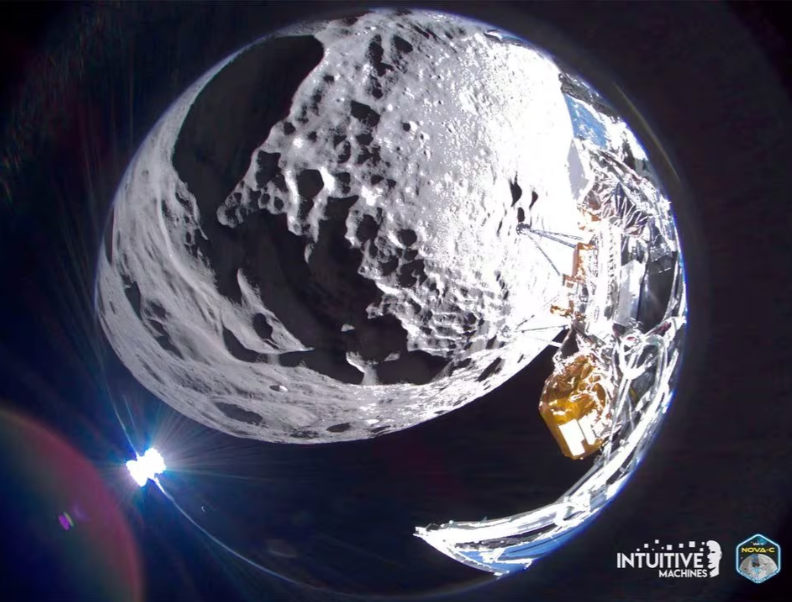The company that built the moon lander, named Odysseus, announced on Friday that the spacecraft, which is the first private spacecraft to reach the lunar surface since 1972, is “alive and well” but laying on its side a day after making a dramatic, first-ever landing.
The spacecraft’s laser-based range finders malfunctioned due to human error, according to Houston-based Intuitive Machines (LUNR.O). The engineers discovered the issue by coincidence a few hours before landing, and they quickly devised an emergency remedy that prevented the mission from likely crashing.
At a press conference the following day, company representatives revealed that while the Odysseus landed safely on Thursday, flight engineers’ data analysis revealed the six-legged craft appeared to trip over its own feet as it approached the end of its final descent.
According to CEO Stephen Altemus, whose business developed and flew the lander, it is thought that the spacecraft caught one of its landing boots on the uneven lunar surface and toppled over, coming to rest sideways, propped up on a boulder at one end.
Nevertheless, Altemus informed reporters that Odysseus “is stable near or at our intended landing site,” which is near a crater known as Malapert A near the moon’s south pole.
According to Altemus, “we do have communications with the lander,” and mission control personnel are giving the craft instructions. They are also attempting to get the first photographs of the lunar surface from the landing location.
Earlier on Friday, the company’s website had a brief mission status report that declared Odysseus “alive and well.”
The 13-foot-tall hexagonal cylinder known as Odysseus was supposed to land upright, according to radio signals received by the business immediately after touchdown on Thursday. However, Altemus stated that the incorrect conclusion was based on telemetry obtained before to the landing.
The sideways’ downward slope
All but one of the lander’s six NASA science and technology packages were situated on areas of the spacecraft left open and receptive to communications, “which is very good for us,” Altemus said, despite the fact that the lander’s sideways posture is far from optimal.
He went on, “We think we can meet all the needs of the commercial payloads.”
However, Altemus stated that communications with the lander will be restricted because two of the spacecraft’s antennae were left pointing at the surface.
The state of the solar panel atop Odysseus, which is currently facing the incorrect direction, is also unknown, but the spacecraft’s batteries had been fully charged and a second array on its side seemed to be operational, he added.
After a nerve-wracking final approach and descent during which a navigation system malfunction forced flight controllers on Earth to use an unproven workaround to avert a potentially disastrous crash landing, the unmanned robot spacecraft touched down on Thursday.
Before the lander’s flight into space last Thursday, business engineers at NASA’s Kennedy Space Center in Florida unintentionally forgot to unlock a safety button, rendering the original laser-powered range finders inoperable, according to Altemus.
“That was an oversight on our part,” he added, drawing a comparison between the neglected switch and a gun’s safety feature.
Only a week later, during lunar orbit, and with only hours to spare before landing, flight controllers were accidentally identifying the problem while debugging another problem.
If not, mission director Tim Crain stated, they might not have known the safety lock was still in place until it was time to turn on the range finders in the final five minutes of the fall.
According to business executives, tensions increased when engineers discovered that the spacecraft’s current software was unable to bypass the safety lock and turn on the range finders.
In the end, programmers hurried to build software that instructed the lander to depend instead on an experimental NASA Lidar payload, which is a remote sensing device that measures object distances by measuring quick pulses of laser-like light and their reflections.
NASA’s Lidar, which was used under tremendous pressure, saved the day even though it was only supposed to be used as a technology showcase and potential backup.
Former SpaceX mission director Abhi Tripathi stated, “It’s really high stakes.” “The mission director has to make sure everyone does their job, and does their job perfectly, almost like a conductor.”
According to Crain, the spacecraft “performed flawlessly” on its seven-day journey to and in orbit around the moon, burning liquid methane and liquid oxygen for the first time in space as a motor fuel.
Soon after landing, Odysseus’s status was unclear. Restoring contact with the spacecraft and learning its fate some 239,000 miles (384,000 km) from Earth required some time following a predicted radio blackout.
During a livestream of the event on Thursday evening, company officials claimed that when contact was finally restored, the signal was weak, confirming that the lander had touched down but leaving mission control immediately confused as to the specific condition and position of the spacecraft.
According to Crain, the lander’s payloads should be able to function for nine or ten days, at which point the sun will have set on the polar landing site.
Intuitive Machines’ stock fell 30% during extended trading on Friday, erasing all of the company’s gains during the previous trading session after the business announced that one of its lunar landing vehicles had overturned.
I am a dedicated student currently in my seventh semester, pursuing a degree in International Relations. Alongside my academic pursuits, I am actively engaged in the professional field as a content writer at the Rangeinn website.







